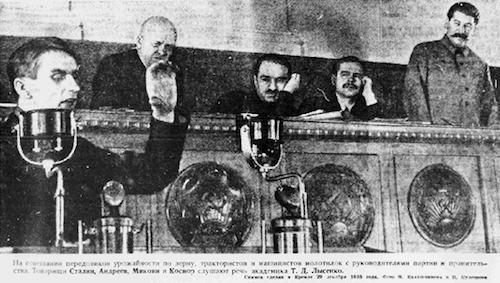 Evolution
Evolution
 Intelligent Design
Intelligent Design
The Truth about Soviet Science and Darwinian Evolution Isn’t as Darwinists Would Like Us to Believe

As an article at The Conversation by Professors Ian Godwin and Yuri Trusov observes, “The tragic story of Soviet genetics shows the folly of political meddling in science.”
There is much truth in the article, but its authors assume that during the era of Trofim Lysenko the Soviet government persecuted people who “embraced evolution and genetics.” On this point, they quote “Australia’s Chief Scientist, Alan Finkel, [who] mentioned him [that is, Lysenko] during a speech at a meeting of chief scientists in Canberra.”
They continue:
The emerging ideology of Lysenkoism was effectively a jumble of pseudoscience, based predominantly on his rejection of Mendelian genetics and everything else that underpinned [Nikolai] Vavilov’s science. He was a product of his time and political situation in the young USSR.
In reality, Lysenko was what we might today call a crackpot. Among other things, he denied the existence of DNA and genes, he claimed that plants selected their mates, and argued that they could acquire characteristics during their lifetime and pass them on. He also espoused the theory that some plants choose to sacrifice themselves for the good of the remaining plants — another notion that runs against the grain of evolutionary understanding.
In fact, the Soviet government embraced Darwinian evolution (which according to Darwin’s own writings contained Lamarckian elements), and persecuted Mendelian genetics, which was considered to be a threat to Darwinism. For more, see the abridged excerpt below from Chapter 16 of my 2006 book The Politically Incorrect Guide to Darwinism and Intelligent Design:
American Lysenkoism
When Mendelian biologists criticized Trofim Lysenko, he simply evaded their arguments and declared that Mendelian genetics was unacceptable because it contradicted Darwinian evolution.1 By then, many Western biologists were accepting the “modern synthesis” of Darwinian evolution and Mendelian genetics, but Soviet Minister of Agriculture Jakov Jakovlev supported Lysenko by declaring Mendelism to be incompatible with true Darwinism. In 1937, Prezent praised Lysenko for “marching under the banner of reconstruction of biological science on the basis of Darwinism raised to the level of Marxism,” while he demonized the Mendelians as “powers of darkness.”2
If government officials and Darwinist ideologues had not come to Lysenko’s rescue, the Mendelians would probably have prevailed — as they did outside the Soviet Union — because they had better science on their side. Lysenko’s Stalinist suppression of Mendelians in the 1940s made matters much worse, but the underlying problem was that the government-supported scientific establishment had chosen to support one side in a scientific dispute. For many years, biologists in the Soviet Union were persecuted by the government if they challenged the official view of Darwinian orthodoxy or defended Mendelian genetics.3
So, contrary to the claims of [American Darwinists], the scientific conflict underlying Lysenkoism was not Lamarckism against Darwinism, but classical Darwinism (which had undeniably Lamarckian elements) against the new Mendelian genetics. The present conflict between neo-Darwinism and intelligent design resembles Lysenkoism in the sense that the Darwinists are still opposing new ideas.
Darwinists would like us to believe that ID proponents — like Lysenko — want to use the government to oppose evolution. But as often happens, Darwinists have things exactly upside-down. Stalin and Lysenko were Darwinists who persecuted Mendelians, just as modern Darwinists persecute IDers (though, thank God, they haven’t imprisoned us). In fact, Darwinism is at the root of the persecution in both cases. And like Mendelism, ID is better science than Darwinism.
So the lesson is legitimate: Don’t allow the government to use its power to enforce a particular view on a scientific question. If only the government would stay out of the evolution-ID controversy!
Notes:
(1) Nils Roll-Hansen, The Lysenko Effect: The Politics of Science (Amherst, NY: Humanity Books, 2005), 86-89. Valery N. Soyfer, Lysenko and the Tragedy of Soviet Science (New Brunswick, NJ: Rutgers University Press, 1994), 63. David Joravsky, The Lysenko Affair (Cambridge, MA: Harvard University Press, 1970), 208, 238-239. Zhores Medvedev, The Rise and Fall of T. D. Lysenko (New York: Columbia University Press, 1969), Chapter 3.
(2) Roll-Hansen, 218-220. Medvedev, 46-49.
(3) Medvedev, Chapter 11. Loren R. Graham, What Have We Learned about Science and Technology from the Russian Experience? (Stanford, CA: Stanford University Press, 1998), Chapter 1 and Conclusions. Roll-Hansen, Chapter 10.
Photo: Trofim Lysenko (left) at the Kremlin, with Stalin (far right), via Wikicommons.
